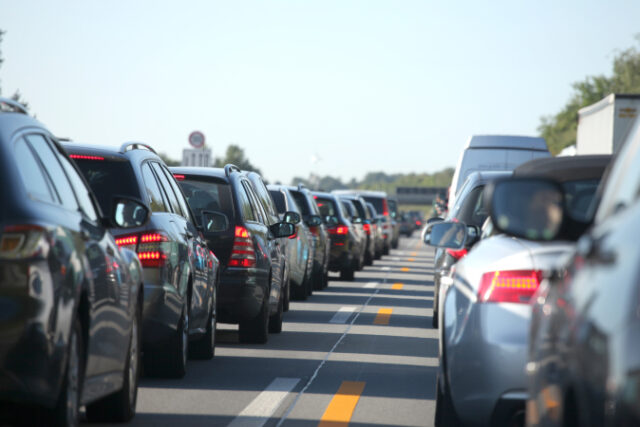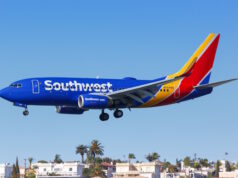
Google searches for “downtown Miami traffic” skyrocketed 350% since August.
- Miami ranks #3 WORST US city to drive in
- The Magic City outpaced L.A., Austin, & Boston for its terrible traffic!
- Miami’s traffic is 36% worse than Jacksonville’s, 40% worse than Tampa’s, and 46% worse than Fort Myers’
- Miami ranks in the bottom five cities nationwide for congestion levels (28% increase in travel time) and traffic jams (420 per day during rush hour)
We analyzed data from multiple sources to find out which cities ranked the worst for delivery and courier drivers.
Key takeaways
- The worst cities for driving are New York City, Chicago, Miami, Austin, and Los Angeles.
- Chicago drivers lost an average of 104 hours to traffic congestion during peak rush hour in 2021.
- Chicago, New York, and San Antonio had the most distracted driving fatalities in 2020.
- Delivery drivers in Denver make the most stops along their routes — an average of 136.
Driving headaches
Cities can become well-known for many different qualities: Los Angeles is the nucleus of the entertainment industry, while New York City is beloved for its theater and pizza. But unfortunately, many are also famous for their traffic congestion — another thing Los Angeles and New York City are famous for.
But is it really as bad as they say?
We analyzed data from the TomTom Traffic Index Ranking, INRIX Global Traffic Scorecard, and NHTSA Fatality and Injury Reporting System to find out which American cities truly are the worst for drivers — especially for courier drivers who navigate these roads every day.
The worst of the worst
Sitting in traffic is no fun, but it can be especially headache-inducing in certain cities. We ranked the best and worst cities to drive in based on:
- Congestion level
- Number of traffic jams
- Traffic jam length
- Hours lost during congestion
- Driving speeds
- Distracted driving fatalities
(Check out the methodology at the end for more info.)
New York City took the top spot as the worst city for driving, scoring a total of 78.75. Chicago followed next, with a score of 71.56.
Miami came in third, while Texas was home to three of the top ten worst: Austin, San Antonio, and Houston. Imagine having to plan routes and schedules for delivery drivers in these cities!
Atlanta — known for its traffic congestion — was actually the most bearable city out of the top 10, but it still ranked worse than Washington, D.C.
Key Takeaway: New York City is the worst city for delivery and courier drivers in America.
Congested nation
In the next part of our study, we analyzed the cities with the most congestion and traffic jams, further breaking down their most insufferable driving aspects. If you manage courier drivers in a major metro area, you might already know what’s coming next.
New York City won the unfortunate title of the most congested city, with a 35% congestion level. This means that, on average, it can take 35% longer to get somewhere during periods of high traffic congestion in New York.
For example, a trip that normally takes 30 minutes could take 10-11 minutes longer during rush hour. It’s certainly bound to cause some headaches.
Dispatchers like you will need to account for delays like these when planning delivery routes for your drivers around the Big Apple.
Los Angeles followed with the next highest congestion level (33%), and Miami came in third (28%). These three cities also had the most traffic jams, but New York City took the top spot in this category with a staggering 783.
As for the total amount of time people lost while sitting in traffic, another city stood out: Chicago, where Windy City drivers lost a total of 104 hours in 2021 alone. New York was just slightly behind, with 102 hours lost to traffic congestion in the same year.
Key Takeaway: Chicago drivers lost the most hours to traffic congestion, but New York is the most congested city in the country.
So many stops
Stop-and-go driving is a pain, especially for delivery workers with schedules to stick to and goals to meet. Next, we looked into which cities had the most stops along delivery routes.
The busiest dispatchers and drivers appear to be in Denver, where there isn’t as much congestion as in other large cities. On average, Denver had the most delivery stops at 136 per day. Atlanta came in second with drivers averaging 115 daily stops, but as we’ve already noted, they also have to deal with a ton of traffic congestion on their busy routes.
The numbers then dropped drastically: Charlotte came in third with 79 stops, and Greenville had only 31 (the least of all the cities we analyzed).
Key Takeaway: Delivery drivers in Denver, Atlanta, and Charlotte make the most stops each day, and drivers in Greenville make the least.
Driving you crazy
Every major metropolis is bound to have traffic, but there are some in particular that you’ll definitely want to avoid driving in during rush hour when possible.
Let’s just say there’s a reason many New York City residents don’t drive — and it’s not just the sky-high cost of parking. Drivers there may have a tough time getting around, but if your team has routes in Atlanta, keep in mind that they might make about 115 stops per day in addition to dealing with heavy traffic.
Just one more reason to be kind to the people out there delivering packages, no matter where or who you are.
Methodology
We collected data from the 2021 TomTom Traffic Index Ranking, the INRX 2021 Global Traffic Scorecard, and the NHTSA Fatality and Injury Reporting System. The following variables were used in the metaranking:
- Congestion level: This means that, on average, travel times were X% longer than during the baseline non-congested conditions. For example, a 20% congestion level means a 30-minute trip in free flow conditions will take 6 minutes longer.
- Number of traffic jams: This was based on the number of traffic jams on August 22, 2022, between 4 p.m. and 6 p.m., when the data was collected. It’s subject to change.
- Traffic jam length in miles: This was based on the length of traffic jams on August 22, 2022, between 4 p.m. and 6 p.m., when the data was collected. It’s subject to change. Data was converted from kilometers to miles.
- Hours lost during congestion: This means the total number of hours lost in congestion during peak rush hour compared to free flow conditions.
- Driving speed: This was the speed of travel in mph within one mile of the downtown core (the lower the speed, the lower the score), calculated as an average using 2021 data.
- Distracted driving fatalities: This was the total number of fatal crashes involving a distracted driver in 2020.
Source: News release














